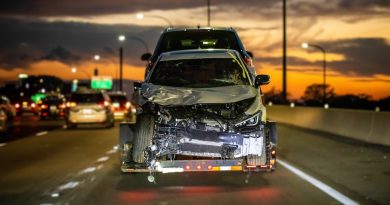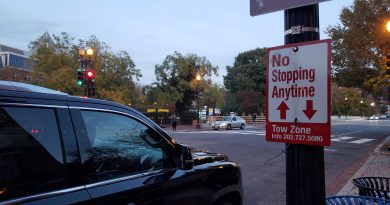It’s Time To Talk About Speed. No, Not The Adderall Shortage.
Yes, folks, I fear it is. This question has come up a lot recently for me as a sort of cosmic convergence on Threads, LinkedIn, Reddit, and Twitter. It brings to mind an article I wrote in January (but ultimately didn’t publish). The article I wrote after being blocked on Facebook by a longtime friend, who shall remain nameless (but works for a local company). Friend was appalled when I suggested that she perhaps not brag about getting out of a speeding ticket, because, well, speed kills, frankly, and you don’t need to be driving the giant SUV you complainbrag about having to drive 70 hours a week, 37mph in a 25mph street with pedestrian and cyclist traffic. We are, generally, really addicted to speed, and it’s killing a lot of people. Michigan has seen a 22% increase in fatalities over recent years, even combined with a 4% decrease in VMT (largely pandemic-related but also helped by the fact that the state isn’t growing). How can we fix it? Hint: It’s not the texting.
Let’s discuss the specifics.
Let’s use a simple comparison between a fully-equipped Ford F-150, the state animal of Michigan, and the (not small, adult) human author of this post, riding an eBike fully loaded with groceries. The F-150 running a stop sign at 10mph has the equivalent momentum to the cyclist traveling at a speed of about 230mph. How did that math work? Momentum is defined as the product of velocity times mass. Even I remembered that as a C student in Shawn Lemke’s IB Physics class at JP McCaskey High School. (An engineer reminded me during this napkin math session that “energy” isn’t the same as “momentum,” and that the comparison is therefore perhaps less extreme than I am saying, but you know what? Let me have this one thing!).

Even when I was in my best cycling shape, I can’t ride my bike 230mph, but trucks frequently speed in excess of posted speed limits. Increased speed limits in many jurisdictions and the growing size and weight of vehicles over the past forty years, whether a Chevrolet Tahoe (5500 lbs) or a Tesla Model S (a featherweight at 4700 lbs), are implicated directly in the vastly increased rates of fatalities from vehicle-to-vehicle crashes, and vehicle-to-pedestrian or cyclist crashes in the past few years.
Still, there are a lot of journalists who continue to believe that it’s actually the fault of distracted driving. Or, perhaps worse, journalists who continue to write about pedestrian fatalities in the passive voice: “pedestrian struck and killed by SUV,” rather than, “driver kills pedestrian.” (An analysis by Streetsblog found that only 4% of articles examined used the active voice). Distracted driving is a huge problem, but it’s one that is going to be easy enough to legislate in a small way (banning the use of handheld devices while driving, as Michigan just shockingly did), and hard to legislate in a comprehensive way (perhaps guiding automakers to stop turning their cars into giant computer consoles? Just a thought?).
Reducing Speed, If Not Vehicle Size
As trucks aren’t getting any smaller, and the well-meaning liberals want to decarbonize transportation one electric SUV at a time (because they can’t be bothered to ride a bike or take the bus like normal people do), this means we’re going to have to deal with heavier cars and trucks, which incur more wear to roadways, and which are more likely to kill you in the event of a crash.
Therefore, if we wanted to actually build a safer society, speed limits should all be lowered to 55mph. Why?
- This would have little to no negative effect on traffic congestion, and might even improve traffic! Most congestion is caused by hard braking and by crashes. Crashes can be reduced by improved responsiveness of drivers, and drivers can respond better when they’re not driving as fast. As explained in greater detail in the next section, reducing the incidence of hard braking would reduce the incidence of what are known as traffic waves or traffic shocks. When you brake, everyone behind you brakes or slows down. Even if it’s just a little bit, these effects can ripple out for miles. This phenomenon is well-understood, as is the fact that higher speeds result in more extreme shocks.
- This would create only a minimal impact on the average commute speed, which is much lower than 55mph anyway, even with highway travel considered.
- This substantially reduces fuel costs for the average commuter, because most cars operate more efficiently at 55mph. Most cars are geared to operate most efficiently at rotational speeds of under 2000rpm. This is why a car like a Dodge Challenger can at higher fuel efficiency in top gear at higher speeds, but why our Honda peaks at around 38mpg when traveling under 2000rpm (usually ~55mph). Oh, and also? Aerodynamic drag increases exponentially with respect to speed.
Same Reaction Time At Higher Speeds = More Dangerous
Let’s also compare the reaction time of drivers and how that plays out for higher versus lower speeds. If a driver takes 1.5 seconds to respond to something in the roadway ahead, that time frame is the difference between traveling 187 feet at 85mph and traveling 121 feet at 55mph. 67 feet is enough space to fit about four parking spaces, or several cars in heavy traffic.
It might be surprising, of course, to think that a car can cross a whole football field in less than three seconds in a car driving at what are fairly common speeds on Michigan highways, but then again, most people are surprised when they hear that we actually have really easy, affordable ways to prevent the majority of the deaths of 40,000 people killed each year in traffic violence.

To Rain On One’s Parade.
Suffice it to say, we are, sadly, unlikely to see serious discussion about this. Why? Because road engineers don’t believe in science, and because most Americans believe that the right to drive as fast as you want is a divine right. Also because the auto industry doesn’t seem to have a vested interest in reducing fatalities, unless someone develops a clever method to try and sue them for their vehicles resulting in higher rates of more-lethal injuries and destruction.
But I am still under the impression that we should at least try to design infrastructure to encourage safer behavior. It’s always a good time to discuss how speed can negatively affect you and your family. While the Adderall shortage might be affecting you, let’s focus on the speed we can control.





